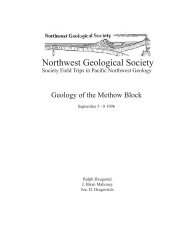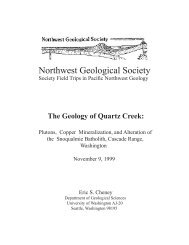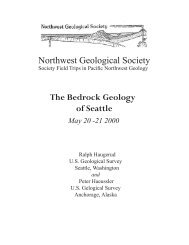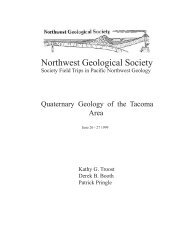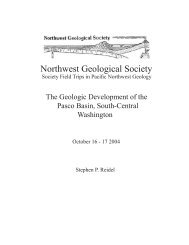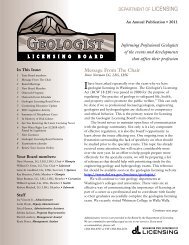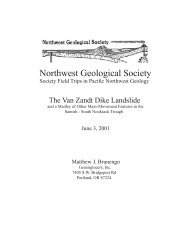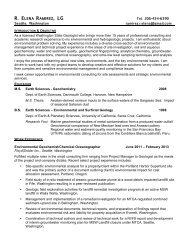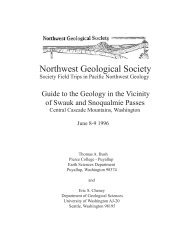Page 1 EVIDENCE FOR LATE QUATERNARY AND HOLOCENE ...
Page 1 EVIDENCE FOR LATE QUATERNARY AND HOLOCENE ...
Page 1 EVIDENCE FOR LATE QUATERNARY AND HOLOCENE ...
Create successful ePaper yourself
Turn your PDF publications into a flip-book with our unique Google optimized e-Paper software.
<strong>EVIDENCE</strong> <strong>FOR</strong> <strong>LATE</strong> <strong>QUATERNARY</strong> <strong>AND</strong> <strong>HOLOCENE</strong> EARTHQUAKES INWESTERN <strong>AND</strong> CENTRAL WASHINGTONDuring this excursion, you will see geologic evidence for prehistoric earthquakeson the Seattle fault zone and in the Yakima fold and thrust belt. Geologists concluded thatthe Seattle area was struck by a large earthquake about 1100 years ago, based on diverselines of evidence that were reported in a series of articles in Science (1992, v. 258, p.1611-1623). The evidence includes sudden uplift and subsidence adjacent to a majorreverse fault near Seattle (the Seattle fault), tsunami-laid sand on two historical tidalmarshes in central and northern Puget Sound, several landslides that slid into LakeWashington in the same season of the same year as the tsunami in Puget Sound, a layer ofgraded sediment (turbidite) in Lake Washington, and a series of rock avalanche-dammedlakes in the eastern Olympic Mountains.LIDAR mapping throughout the Puget lowland reveals several scarps cuttingacross the glacial landscape. Trenching studies across scarps in the Seattle fault zoneexposed evidence for a cluster of late Holocene earthquakes on the Seattle fault zone.On this field trip, you will see sites where geologists collected evidence forsudden uplift, subsidence, and surface rupture that accompanied these large earthquakes1100 years ago.Road Log - Day 1 (See Figure 1A)Mileage0 Start mileage at ramp onto Interstate 5 from Olive Way in downtown Seattle.2.9 Take I-5 south to the West Seattle Freeway. Head west on West Seattle Freewayand cross West Seattle Bridge over the Duwaumish Waterway south of HarborIsland.5.3 Take the Harbor Avenue/Avalon Way exit from West Seattle Freeway.5.5 Turn right at stoplight at end of exit ramp onto Harbor Avenue.7.2 Stop at parking spaces along Harbor Avenue. Walk N-NW along Harbor Avenueto a small park at Duwaumish Head (look for the big anchor).STOP 1 – OVERVIEW OF THE SEATTLE FAULT ZONE FROM DUWAUMISHHEADNear-surface faults in the Puget Sound region accommodate contraction ofwestern Washington between the Coast Ranges of Oregon and British Columbia (Wellset al., 1998) (Fig. 2). The contraction has produced east-trending uplifts, basins, andassociated reverse faults that traverse Puget Sound. The faults, which separate areas ofcoastal uplift and subsidence were first identified from geophysical lineaments (Danes etal., 1965). New geophysical data (Brocher et al., 2001) confirm that one fault zone passesbeneath Seattle and another beneath Tacoma (Figures 3 and 4). The Seattle fault zonemarks the northern edge of an area of crustal uplift, the Seattle uplift, whereas theTacoma fault zone bounds this uplift on the south (Blakely et al., 2002; Brocher et al.,2001; Johnson et al., 1999; Pratt et al., 1997). The two zones probably have similar<strong>Page</strong> 1
structural relief—as much as 10 km since the Eocene, in the case of the Seattle fault—because they coincide with geophysical anomalies of similar amplitude.A high-resolution aeromagnetic survey of the Puget Lowland (Figure 3) showsdetails of the Seattle fault zone (Blakely et al., 2002). Three east-trending magneticanomalies are associated with north-dipping Oligocene and Miocene strata exposed in thehanging wall; the magnetic anomalies indicate where these strata continue beneathQuaternary glacial deposits. The northernmost anomaly, a magnetic high, correlates withmagnetic Miocene volcanic conglomerate of the Blakely Harbor Formation. The middleanomaly, a broad magnetic low, correlates with thick, nonmagnetic Eocene andOligocene marine and fluvial strata. The southern anomaly, a broad magnetic high,correlates with Eocene volcanic and sedimentary rocks. This tripartite package ofanomalies is especially clear over Bainbridge Island west of Seattle and over the regioneast of Lake Washington. The anomalies roughly follow the path of the Seattle-Bainbridge Island ferry across Puget Sound. Beneath Seattle, the anomalies becomeattenuated, although the pattern can be correlated with the strike of beds in a northweststrikinganticline beneath Seattle.Mileage7.2 Head west on Harbor Avenue from Duwaumish Head parking area (note: HarborAvenue turns into Alki Avenue just after Duwaumish Head). The road crossesonto an uplifted intertidal platform near the intersection of Alki Ave. andBoudouin St.9.5 Follow Alki Avenue to the west (past the famous Alki Bakery) to intersection atend of Alki Ave. Turn left from Alki Ave. onto Beach Drive (at end of AlkiAve.).9.6 Park at intersection of Beach Drive and Benton Place SW.STOP 2 – ALKI POINT (BEDROCK GEOLOGY, INTERTIDAL PLAT<strong>FOR</strong>M,UPLIFTED PLAT<strong>FOR</strong>M)The evidence for earthquake-induced uplift about 1000 years ago in central PugetSound consists of geomorphic and stratigraphic features that record sudden changes inthe relative elevation of sites along the coast. The most dramatic and conspicuous ofthese features is a raised wave-cut platform at Restoration Point on Bainbridge Island, 5km west of Seattle, and at Alki Point in West Seattle. Geologists proposed that uplift ofthis platform was the result of seismic slip on the Seattle fault, which extends westwardacross Puget Sound from Seattle. The northern-most fault strand crosses Puget Soundroughly along the same path as the Seattle-Bainbridge Island ferry.We will examine a modern intertidal platform cut on Tertiary bedrock and anuplifted wavecut platform at this stop. Bedrock consists of Oligocene marine sedimentslocated on the northern limb of an east-west trending anticline. This anticline is in thehanging wall of the Seattle fault zone. An earthquake on this fault zone about 1100 yearsago uplifted an intertidal platform about 7 meters at this location. The platform and<strong>Page</strong> 2
former shoreline angle are preserved in the area behind the sewage treatment plant andBeach Dr. and Benton Place.Mileage9.6 Continue south on Beach Drive to stop sign.9.9 Turn right at stop sign at intersection of Beach Drive and 63 rd Ave SW (BeachDrive continues to the south after you make this turn). Beach Drive is constructedon the intertidal platform uplifted during an earthquake about 1100 years ago10.7 Park along Beach Drive at Mee Kwa Mooks Park.STOP 3 – ME KWA MOOKS PARK (UPLIFTED PLAT<strong>FOR</strong>M, OLYMPIA BEDS,OFFSET PLAT<strong>FOR</strong>M)At this stop, we will examine a wave-cut platform uplifted 1100 years ago.Elevations of raised shoreline angles in this area suggest anomalously large amounts ofuplift of ~10 m or more. Folded Olympia-age sediments (~20,000 yrs old, pre-Vashon)are exposed in the intertidal area adjacent to the concrete wall at Me Kwa Mooks Park(Figs. 5 and 7). Possible origins of these folds include landsliding, glaciotectonics, andmovement on the Seattle fault zone. South of these folds, near the intersection ofJacobsen St. and Beach Drive, a north-side-up scarp crosses the raised platform. (Fig. 6).The anomalous uplift measured at Me Kwa Mooks Park led Kelsey et al. (2008)to question whether the uplift was the result of more than one Holocene earthquake. Theplatform here is offset by the ‘West Seattle fault’ (informal name), an east-trending,north-side-up reverse fault near the intersection of Beach Drive SW and SW AlaskaSt./SW Jacobsen Rd. Hand augering and surveying shows that the West Seattle faultoffset the raised platform by ~1.5 m. Therefore at this site, the regional-uplift earthquake,involved slip on both a north-vergent master ramp at depth (~6 km based on seismicreflection surveys) and the south-vergent West Seattle fault at the surface. A locallyhigher terrace extends ~300 m north of the West Seattle fault and is ~5 m higher than theregionally uplifted shore platform — this higher terrace cannot be explained by only 1.5m of up-to-the-north offset of the lower platform. Kelsey et al. (2008) inferred that thisterrace is evidence for an older, higher shore platform only present immediately north ofthe West Seattle fault. However, they could not accurately determine the elevation of thehigher platform because both extensive urbanization of the higher terrace and landslidingof its paleosea cliff to the east prevent augering through the cover sediment. Kelsey et al.(2008) observed similar geomorphic relationships along two much better exposed andless urbanized faulted shore platform sites on the west coast of Bainbridge Island and atPoint Glover in Kitsap County.Mileage0.1 Head southeast on Beach Dr SW toward SW Snoqualmie St; go 0.1 mi0.5 Take the 3rd left onto SW Alaska St; go 0.4 mi0.6 Continue onto SW Hudson St; go 0.1 mi0.9 Turn left onto 50th Ave SW; go 0.3 mi<strong>Page</strong> 3
1.6 Take the 2nd right onto SW Alaska St; go 0.7 mi1.8 Turn left onto Fauntleroy Way SW; go 0.3 mi1.9 Continue straight to stay on Fauntleroy Way SW4.6 Continue onto W Seattle Bridge; go 2.7 mi5.9 Keep left at the fork, follow signs for Vancouver B C and merge onto I-5 N; go1.3 mi14.8 Take exit 164A to merge onto I-90 E toward Spokane; go 8.8 mi15.3 Take exit 11A for 150th Ave SE; go 0.6 mi15.4 Follow signs for SE 37th St; go 79 ft15.9 Continue straight onto SE 37th St; go 0.6 mi16.3 Continue onto SE 35th Pl; go 0.4 mi16.7 Continue onto SE 34th St; go 0.3 mi16.8 Turn right onto W Lake Sammamish Pkwy SE. Destination will be on the right;go 0.2 mi. Park at the big red barn.STOP 4 – VASA PARK, WEST SHORELINE OF LAKE SAMMAMISHAt this stop, we will examine a small fault scarp along one of the main strands of theSeattle fault zone at Vasa Park. Fault strands in the eastern part of the Seattle fault zone(SFZ) ruptured the ground surface at least two times in late Quaternary time. Previouspaleoseismic evidence for late Holocene surface faulting along the SFZ focused on northdippingthrust faults between Seattle and Bremerton. In contrast, several exposures alongthe SFZ east of Seattle show evidence for surface rupture on south-dipping thrust faults.At Factoria, about 12 km east of Seattle, a ravine crossing the fault zone exposesproglacial lake sediments thrust over younger outwash to the north. Locally, this faultmay account for a south side up topographic scarp. At Vasa Park on the west shore ofLake Sammamish about 16 km east of Seattle, recent excavations at two sites exposed aW to NNW-striking fault zone. At the RipRap site, NNW-striking subvertical dip-slipfaults form a contact between glacial till and Miocene bedrock, and appear toaccommodate bedding-plane slip in the steeply dipping till. The vertical faults mergeupward with or are truncated by SW-dipping thrust faults in the overlying bedrock. Aradiocarbon age on charcoal immediately overlying bedrock-derived colluvium suggeststhat the last event occurred between ~16,000 and ~4500 years BP. At the Blackberrytrench about 200 m east of the RipRap site, Miocene volcanic mudstone and Quaternaryglacial deposits are thrust northward over late Quaternary glacial deposits and a Holoceneforest soil. Stratigraphic relationships suggest at least 3 m of horizontal motion and 2m ofvertical motion during the last earthquake. A radiocarbon age on charcoal at the top of theburied soil indicates that the last event postdates 12,390 – 12,050 cal yrs BP. Thrust faultseroded by a late Pleistocene (?) stream channel eroded into the hanging wall suggest atleast one earlier episode of faulting.*************************** END OF DAY 1 ******************************Road Log - Day 2 (see Figure 1B)Mileage0.6 Turn left onto SE Eastgate Way; go 0.5 mi0.7 Turn right onto 148th Ave SE/150th Ave SE Continue to follow 150th Ave SE;go 0.2 mi<strong>Page</strong> 4
99.9 Merge onto I-90 E via the ramp to Spokane; go 99.1 mi101 Slight right onto US-97 S (signs for I-82 E/Yakima); go 0.9 mi126 Continue onto I-82 E; go 25.7 mi127 Take exit 26 for WA-821 N toward WA-823/Selah. Turn right onto WA-821 N129 Take the 1st left onto WA-823 S/Harrison Rd; go 1.9 mi132 Sharp right onto N Wenas Rd; go 2.9 mi146 Turn left to stay on N Wenas Rd; go 13.7 mi146 Turn right onto Black Canyon Rd; go 0.8 mi147 Take the 1st left onto Elk Ridge Ln; go 0.5 miSTOP 5 – WENAS VALLEY, UMTANUM RIDGE SCARPAt this stop, we will examine a scarp running along the north side of Wenas Valley at thebase of the southern limb of the Umtanum Ridge anticline. The linear scarp runs alongthe northern edge of Wenas Valley for about 11 km, approximately 400 m south of thesteeply dipping south flank of Umtanum Ridge (Figure 8). The scarp trends westnorthwestand varies in height from ~2 m to over 8 m, and lies on a relatively flat alluvialfan surface that slopes southward towards Wenas Creek at about 1 to 9 degrees. Anaeromagnetic lineament that tracks the flank of Umtanum Ridge lies parallel to the scarp— the scarp and magnetic lineament are offset ~400 m, but the scarp follows each bendand wiggle of the magnetic lineament. This close association between scarp and magneticlineament suggests that the scarp may be structurally controlled and caused by the samestructure that generates the magnetic lineament. The Wenas Valley scarp is related toeither recent faulting along the southern flank of Umtanum Ridge or deep-seatedlandslides.An excavation across the scarp at McCabe Place revealed a sequence of volcaniclasticalluvial deposits, cobble-rich debris-flow deposits, angular unconformities, and buriedsoils (Figure 9). The oldest exposed deposits (units 1 through 3) are white – creamcolored,sandy silt to cobble-rich silt to sand volcaniclastic deposits. An angularunconformity separates the volcaniclastic deposits from the overlying pumicerich sandysilt (unit 4). Overlying the sandy silt of unit 4 is a gravelly silty sand (unit 5). Both units 4and 5 taper out and disappear in the lower third end of the trench. A dark chocolatebrownsandy clay (unit 6) displaying well-developed prismatic soil structure overlies unit5 and extends along the entire length of the trench. A sandy silt (unit 7) buries thechocolate brown clay in the lower half of the trench and is missing from the upper part ofthe trench. Overlying unit 6 in the upper half of the trench is unit 8, a sandy silt similar inlithology to unit 7 but with slightly different color. Unit 8 buries unit 6 in the upper halfof the trench but buries unit 7 in the lower half of the trench. The entire sequence iscapped by modern surface soil (unit 9), which includes thin pods of tephra from the 1980eruption of Mount St. Helens.Faulting/foldingThe stratigraphic sequence at McCabe Place is broken by several normal faults. Theoldest units also show evidence for folding. Bedding in units 1 to 3 and the unconformity<strong>Page</strong> 5
etween units 3 and 4 form a slight arch, with the apex of the arch about in the center ofthe excavation. F1 to F5 are normal faults that offset the stratigraphy in a down-to-thesouthfashion. F6 to F9 are normal faults that bound two horsts, with the southernmosthorst bounded on the down-thrown side by a small syncline.The stratigraphy, unconformities, and faults exposed in the McCabe excavation suggestat least three episodes of deformation. The total amount of normal faulting is ~3 m, whilethe total scarp height is ~7 m, suggesting substantial deformation not accounted for byfaults evident in the trench. Bedding in the volcaniclastic alluvium is folded and couldaccount for the discrepancy between scarp height and observed faulting. The smallsyncline adjacent to one of the horsts suggests that contraction accompanied movementon faults F8 and F9, which predated movement on the other horst bounded by F7 and F6.The most recent episode of movement is on fault F2, which extends through the entirestratigraphic package except for the modern soil, suggesting a relatively recent age formovement along this fault.We favor an interpretation that the possible folding/faulting of basalt at Hessler Flat andnormal faulting at McCabe Place are due to bending-moment normal faulting in thehanging wall of an oblique and blind thrust fault, or from normal faulting accompanyingdevelopment of a small pull-apart basin. A blind thrust may be the cause of theaeromagnetic lineament 400 m to the north that closely parallels the entire Wenas Valleyscarp. Although alternative explanations for the Wenas Valley scarp are possible, such asthe headscarp of a shallow landslide or erosion along bedding planes, the length andmorphology of the scarp favors a fault origin.Mileage0.5 Head south on Elk Ridge Ln toward Black Canyon Rd; go 0.5 mi1.4 Take the 1st right onto Black Canyon Rd; go 0.8 mi15.1 Turn left onto N Wenas Rd; go 13.7 mi18.0 Turn right to stay on N Wenas Rd; go 2.9 mi19.9 Turn left onto WA-823 N/Harrison Rd; go 1.9 mi27.3 Turn left onto WA-821 N; go 7.4 mi27.6 Turn right onto Burbank Creek Rd; go 0.3 mi28.3 Slight left to stay on Burbank Creek Rd.; go 0.7 mi28.4 Keep bearing to right; go ~0.1 miSTOP 5 – GUS SPRING SCARP, BURBANK CREEK <strong>AND</strong> UMTANUM RIDGEAt this stop we will examine a possible fault scarp first show to me by Bob Bentley on aninformal field trip in 1998. This scarps lies near and parallel to a magnetic anomaly lyingalong the flanks of Umtanum Ridge and paralleling a mapped thrust fault informallyreferred to as the Burbank fault (Figure 10). This fault follows Burbank Creek just southand east of Mount Baldy. A scarp identified on lidar images also falls near the magneticlineament and lies very close to the mapped trace of the Burbank fault (Schuster, 1994).Another scarp, located about 1 km north of Roza Creek, falls directly on a magnetic<strong>Page</strong> 6
lineament. The magnetic lineament follows a contact between N2 Grande Ronde Basaltand the Frenchman Springs Member of the Wanapum Basalt, both normally magnetized.This scarp and its associated magnetic lineament may be the continuation of the Burbankfault on the west side of the Yakima River canyon, where the fault becomes thesubsurface contact between Grande Ronde and Wanapum Basalt.Mileage1.1 Go back to the WA-821 N/ Canyon Road18.1 Turn right onto WA-821 N/Canyon Rd; go 16.9 mi16.0 Turn right onto WA-821 N/Canyon Rd; go 14.8 miStop 7 – Manastash Ridge strathsAt this stop we will view evidence for three strath terraces at significant elevation abovethe modern Yakima River (Figure 11). The lowest surface is associated with anabandoned river meander lying at ~430 m in elevation. Loess observed in road cuts alongCanyon Road mantles deposits of rounded river cobbles (across road from parking area)suggesting that this meander was abandoned in the late Pleistocene by down cutting ofthe river. Further up Manastash Ridge to the north, an intermediate strath terrace at ~500m in elevation suggests an earlier episode of down cutting by the river. A road cut(private driveway) cuts through this surface and exposes a thin veneer of sedimentsdeposited on the bedrock surface — rounded river cobbles, cross-bedded sands, and finegraineddeposits (loess?). This surface is visible across the river on the western flanks ofthe canyon. A vineyard occupies a third, yet higher surface at ~570 m in elevation. Roadcuts through this surface exposed rounded basalt cobbles sitting on basalt (TylerLadinsky and Harvey Kelsey, Humboldt State University, personal communication).Thanks to Tyler Ladinsky and Harvey Kelsey for information on this stop.Mileage2.1 Head north on WA-821 N/Canyon Rd past Canyon Ranch Rd; go 2.1 mi7.3 Turn right onto WA-821 N/Thrall Rd. Continue to follow Thrall Rd; go 5.2 mi9.4 Turn left onto Badger Pocket Rd; go 2.1 mi12.0 Turn right onto Carroll Rd; go 2.7 mi. Park in turnout at top of hill on right sideof gravel road.STOP 8 – KITTITAS VALLEY <strong>AND</strong> BOYLSTON RIDGE SCARPAt this stop we will examine a recently discovered fault scarp trending NW-SWacross Boylstone Ridge. LiDAR data reveal a scarp cutting across the northwestern endof Boylston Ridge in eastern Kittitas Valley, about 16 km east of Ellensburg (Figure 12).This scarp, referred to as the Boylston Ridge scarp, trends northeast, is up-thrown on itsnorthwestern side, and is 3–4 m high at its highest point. The scarp crosses a small streamvalley adjacent to a highway (streamflow is to the west). Here the stream incises alluvium<strong>Page</strong> 7
that fills the valley on the up-thrown side of the scarp, resulting in a narrow deep ravine.Field reconnaissance suggests that a small wetland or pond may have formed in thestream valley at the time the scarp formed. Down cutting of the stream into lateQuaternary alluvium in the valley suggests relatively recent movement. The scarpcontinues to the northeast and crosses into an alluvium filled valley (part of KittitasValley) and appears to warp the valley surface mapped as Quaternary alluvium. TheLiDAR scarp and an associated aeromagnetic lineament suggest that the Boylston Ridgescarp is a northeast-striking fault at least 15 km in length.ReferencesAtwater, B.F., and Moore, A.L., 1992, A tsunami about 1000 years ago in Puget Sound,Washington: Science, v. 258, p. 1614–1617.Atwater, B.F., 1999, Radiocarbon dating of a Seattle earthquake to A.D. 900–930 [abs.]:Seismological Research Letters, v. 70, p. 232.Blakely, R.J., Wells, R.E., Weaver, C.S., and Johnson, S.Y., 2002, Location, structure,and seismicity of the Seattle fault zone, Washington: Evidence from aeromagneticanomalies, geologic mapping, and seismic-reflection data: Geological Society ofAmerica Bulletin, v. 114, p. 169–177.Brocher, T.M., Parsons, T., Blakely, R.J., Christensen, N.I., Fisher, M.A., Wells, R.E.,andthe SHIPS Working Group, 2001, Upper crustal structure in Puget Lowland,Washington—Results from the 1998 seismic hazards investigation in PugetSound: Journal of Geophysical Research, v. 106, p. 13,541–13,564.Brocher, T,M., Blakely, R.J., Wells, R.E., in review, Reinterpretation of the Seattle uplift,Washington, as a passive roof duplex, Bulletin of the Seismological Society ofAmerica.Bucknam, R.C., Leopold, E.B., Hemphill-Haley, E., Sherrod, B.L., 1999, Lynch Cove, inBucknam, R.C., compiler, Atlas of reconnaissance data from paleoseismic studiesof the Puget Sound region, Washington: U.S. Geological Survey Web site,http://geohazards.cr.usgs.gov/pacnw/paleo/atlas.html.Bucknam, R.C., Hemphill-Haley, E., and Leopold, E.B., 1992, Abrupt uplift within thepast 1,700 years at southern Puget Sound, Washington: Science, v. 258, p. 1611–1614.Bucknam, R.C., Sherrod, B.L., and Elfendahl, G., 1999, A fault scarp of probableHolocene age in the Seattle fault zone, Bainbridge Island, Washington:Seismological Research Letters, v. 258, p. 1611–1614.Danes, Z.F., Bonno, M.M., Brau, E., Gilham, W.D., Hoffman, T.F., Johansen, D., Jones,M.H., Malfait, B., Masten, J., and Teague, G.O., 1965, Geophysical investigationsof the southern Puget Sound area, Washington: Journal of Geophysical Research,v. 70, p. 5573–5580.Haugerud, R.A., Harding, D.J., Johnson, S.Y., Harless, J.L., and Weaver, C.S., 2003,High-resolution lidar topography of the Puget Lowland—A bonanza for earthscience, GSA Today, v. 13, no. 6, p. 4–10.Harding, D.J., and Berghoff, G.S., 2000, Fault scarp detection beneath dense vegetationcover—Airborne laser mapping of the Seattle fault zone, Bainbridge Island,Washington State: Bethesda, Maryland, American Society of Photogrammetry<strong>Page</strong> 8
and Remote Sensing, Proceedings, Annual Conference, 9 p. (on CD).Harding, D.J., Johnson, S.Y., and Haugerud, R.A., 2002, Folding and rupture of anuplifted Holocene marine platform in the Seattle fault zone, Washington, revealedby airborne laser swath mapping: Geological Society of America Abstracts withPrograms, v. 34, no. 5, p. A-107.Johnson, S.Y., Potter, C.J., and Armentrout, J.M., 1994, Origin and evolution of theSeattle fault and Seattle basin, Geology, v. 22, p. 71–74 and oversize insert.Johnson, S.Y., Dadisman, S.V., Childs, J.R., and Stanley, W.D., 1999, Active tectonics ofthe Seattle fault and central Puget Lowland—Implications for earthquake hazards:Geological Society of America Bulletin, v. 111, p. 1042–1053 and oversize insert.Kelsey, H. M., B. L. Sherrod, A.R. Nelson, T.M. Brocher, 2008, Earthquakes generatedfrom bedding plane-parallel reverse faults above an active wedge thrust, Seattlefault zone, Geol. Soc. Am. Bull. 120 (11–12): 1581–1597.Nelson, A.R., Johnson, S.Y., Wells, R.E., Pezzopane, S.K., Kelsey, H.M., Sherrod, B.L.,Bradley, L.-A., Koehler, R.D., III, Bucknam, R.C., Haugerud, R.A., and LaPrade,W.T., 2002, Field and laboratory data from an earthquake history study of the ToeJam Hill fault, Bainbridge Island, Washington: U.S. Geological Survey Open-FileReport 02–60, 2 plates and 37 p. (download at http://pubs.usgs.gov/of/2002/ofr-02–0060/).Nelson et al., 2002Nelson, A.R., Johnson, S.Y., Kelsey, H.M., Wells, R.E., Sherrod, B.L., Pezzopane, S.K.,Bradley, Lee-Ann, Koehler III, R.D. Bucknam, R.C., 2003, Late Holoceneearthquakes on the Toe Jam Hill fault, Seattle fault zone, Bainbridge Island,Washington, Geological Society of America Bulletin, v. 115; no. 11; p. 1388–1403; 7 figures; 1 table; Data Repository item 2003151.Pratt, T.L., Johnson, S.Y., Potter, C., Stephenson, W., and Finn, C., 1997, Seismicreflections beneath Puget Sound, western Washington State: The Puget Lowlandthrust sheet hypothesis: Journal of Geophysical Research, v. 102, p. 27,469–27,489.Sherrod, B.L., Bucknam, R.C., and Leopold, E.B., 2000, Holocene relative sea-levelchanges along the Seattle fault at Restoration Point, Washington: QuaternaryResearch, v. 54, p. 384–393.Sherrod, B.L., 2001, Evidence for earthquake-induced subsidence about 1100 yr ago incoastal marshes of southern Puget Sound, Washington: Geological Society ofAmerica Bulletin, v. 113, p. 1299–1311.Schuster, J.E., 1994, Geologic map of the east half of the Yakima 1:100,000 quadrangle,Washington, Wash. Div. of Geol. and Earth Resources, Open-File Rep. 94–12, 1sheet, 19 p. accompanying text.ten Brink, U.S., Molzer, P.C., Fisher, M.A., Blakely, R.J., Bucknam, R.C., Parsons, T.,Crosson, R.S., and Creager, K.C., 2002, Subsurface geometry and evolution of theSeattle fault zone and the Seattle basin, Washington, Seismological Society ofAmerica Bulletin, v. 92, p. 1737–1753.<strong>Page</strong> 9
Stop 1Stop 4Stop 2Stop 3Figure 1A. Field trip stops on day 1
Stop 4Stop 3Stop 1Stop 2Figure 1B. Field trip stops on day 2
(after Blakely et al., GSAB, February, 2002)?
N75SW Genesee0 500 ftA14C = 27,810130 yr BP-13696799868Mee KwaMooksParkBeach Drive SW7B710SW Oregon6Traceable,resistantpeat layers11111110867C7 51010387SW SnoqualmieSW VillaE877106SW JacobsenFigure 5. Geologic map of intertidal area atMe Kwa Mooks Park, showing folds in~27,000 year old Olympia beds.DSW Angeline
A1.32.02.0 m3m2m1m0mAGround surfacelate HoloceneWave-cut platformlate Pleistocene0 50 meters 100 150A'Cross section along Beach Drive(10 x vertical exaggeration)?A''Sea cliffUplifted beach platform7500UTM Northing (meters)Modernbeach1.5 mEdge of sea cliff2.0 mA'1.71.84.0 m3.5 m3.0 m2.5 m1.50.80.53.91.20.9Inferred fault1.9Elevation contour onwave-cut platform1.5 mPaleo sea cliffPlatform back edgeSurveyed elevation of wave-cutplatform (meters, arbitrary datum)2.0 m0.2A''0.5 m1.0 m0.67400010203040 m1.01.6
Figure 7. Olympia syncline at Me Kwa Mooks ParkOblique Figure aerial 8. image Oblique of uplifted air photo platfrom of uplifted at Restoration plaform Restoration Point, Bainbridge Point, Island, WA.Bainbridge Island, Washington.
Umtanum RidgeWenas Lake1 kmFigure 8. LiDAR image of Wenas Valley (slope map shong percent slope as shades of grey, histogram-weighted geryscalecolor model).
16NEFaultsPrimary fault (with motion indicated)986SW5Inferred faultContacts and BeddingPrimary stratigraphic contactInferred contactSymbolsRadiocarbon sample2B2G1 2A2E2D2C2FF97c2DF82F2D32E4762D2EF5F6F72D2E2D12A2B46F4 F3Sandy siltSandy silt52F2D3Gravelly silty sand84F22DF12F3453?54Sandy siltSandy silt with pumiceGravelly silty sand2CGravelly silty sand6Sandy clayRelative Elevation (m)1086422D2E2F2GSandy siltCobbly silty sandSandy silt with lapilliClay with pumice fragments789Sandy siltSandy siltSandy silt with ashSheared004812 16 20 24 28 32 36 40Distance (m)
A120.55 120.50 120.45 120.40No data46.8546.8046.8546.80B5 km120.55 120.50 120.455 kmUmtanum CreekRoza CreekYakima RiverUmtanum RidgeExplanationScarpBeddingNo data No dataBedding plane scarpMagnetic lineamentLandslideFigure 10. LiDAR along Umtanum Ridge. The Burbank fault runs alongthe south flank of Umtanum on the east side of the Yakima River.
Yakima RiverKittitas Valley(Highest local elevation onManastash Ridge is ~900m)Highest surface(~570m)Intermediate surface(~500m)AbandonedmeanderLowest surface(~430m)Figure 11. Strath terrcaces at Manastash Ridge.
665120.38 120.34 120.3046.9846.96No Data1 km120.38 120.34 120.3061061563562046.98605Interstate 9050551552558059046.961 km515ExplanationPrimary scarp Magnetic lineamentWarpContours = 5 metersSecondary scarpFlexural slip/bedding plane scarpFigure 12. (Top) LiDAR image (slope image), and (Bottom) interpretedarea with contours



